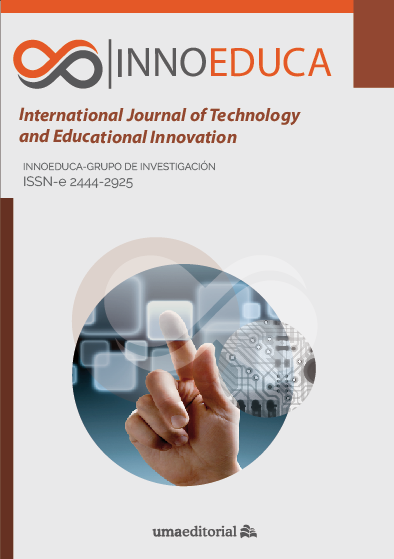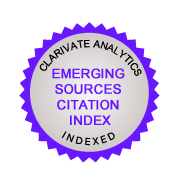Influence of flipped learning on attitudes towards a foreign language subject
DOI:
https://doi.org/10.24310/innoeduca.2022.v8i1.11942Keywords:
attitude, flipped learning, higher education, foreign language, ICTAbstract
For some years now, a different approach to learning, called flipped learning, has been gaining strength. The aim of our study is to analyse the influence of this learning approach on the attitudes of 40 university students towards the subject “language learning through ICT” by means of a practical classroom experience within the subject. For data collection, both quantitative and qualitative techniques were used. The results obtained reveal the students’ preference for flipped learning as opposed to the traditional learning approach. Additionally, an improvement in attitude, motivation, and interest towards the subject has been found, as well as an increase in students’ autonomy and in the interactions among students themselves and between students and the teacher. On the other hand, participants mentioned an improvement in their English and ICT skills. Advantages and disadvantages identified by the participants are also reflected in this paper. After such positive results, it is concluded that this approach needs to be taken into account when organising the teaching process. Therefore, the study also supports the idea that teachers should be adequately trained to incorporate flipped learning into their teaching.
Downloads
Metrics
Publication Facts
Reviewer profiles N/A
Author statements
Indexed in
-
—
- Academic society
- N/A
- Publisher
- Universidad de Málaga
References
Adnan, M. (2017). Perceptions of Senior-Year ELT Students for Flipped Classroom: A Materials Development Course. Computer Assisted Language Learning, 30 (3-4), 204-222.
Al-Naabi, I.S. (2020). Is it Worth Flipping? The Impact of Flipped Classroom on EFL Students’ Grammar. English Language Teaching, 13(6), 64-75. https://files.eric.ed.gov/fulltext/EJ1255482.pdf
Alsowat, H. (2016). An EFL Flipped Classroom Teaching Model: Effects on English Language Higher-order Thinking Skills, Student Engagement and Satisfaction. Journal of Education and Practice, 7(9), 108-121.
Anderson, L. W., & Krathwohl, D. R. (2001). A Taxonomy for Learning, Teaching and Assessing: A Revision of Bloom’s Taxonomy of Educational Objectives: Longman.
Bergmann, J., & Sams, A. (2012). Flip your classroom: reach every student in every class every day. International Society for Technology in Education.
Bloom, B.S. (1956). Taxonomy of educational objectives: The classification of educational goals: Handbook I, cognitive domain. Longmans, Green.
Bond, M. (2020). Facilitating student engagement through the flipped learning approach in K-12: A systematic review. Computers & Education, 151, e103819. https://www.sciencedirect.com/science/article/pii/S036013152030021X
Calvillo, A.J. (2014). El modelo Flipped Learning aplicado a la materia de música en el cuarto curso de Educación Secundaria Obligatoria: una investigación-acción para la mejora de la práctica docente y del rendimiento académico del alumnado [Tesis doctoral, Universidad de
Valladolid]. UVADOC http://uvadoc.uva.es/handle/10324/9138
Cheng, SC., Hwang, GJ., & Lai, CL. (2020). Critical research advancements of flipped learning: a review of the top 100 highly cited papers. Interactive Learning Environments, 1-17. https://doi.org/10.1080/10494820.2020.1765395
Churches, A. (2009). Taxonomía de Bloom para la era digital. http://eduteka.icesi.edu.co/pdfdir/TaxonomiaBloomDigital.pdf
Dafonte, A., Míguez, M. I., & Corbacho, J. M. (2017). La investigación internacional sobre flipped learning en revistas académicas. Estado de la cuestión. En A. Gutiérrez, A. García, & R. Collado (Eds.), Actas del III Congreso Internacional de Educación Mediática y Competencia Digital (pp. 1805-1814). Universidad de Valladolid. http://www.investigo.biblioteca.uvigo.es/xmlui/handle/11093/881
Day, J., & Foley, J. (2006, 22-27 April). Evaluating Web Lectures: A Case Study from HCI. [Conference presentation]. Conference on Human Factors in Computing Systems, Montreal, Quebec, Canadá. https://doi.org/10.1145/1125451.1125493
Flipped Learning Network (FLN). (2014). The Four Pillars of F¬-L¬-I¬-P™. https://flippedlearning.org/wp-content/uploads/2016/07/PilaresFlip.pdf
Hinojo, F.J., López, J., Fuentes, A., Trujillo, J.M., & Pozo, S. (2020). Academic Effects of the Use of Flipped Learning in Physical Education. International Journal of Environmental Research in Public Health, 17(1), e276. https://www.mdpi.com/1660-4601/17/1/276/htm
Hung, H-T. (2015) Flipping the classroom for English language learners to foster active learning. Computer Assisted Language Learning, 28(1), 81-96
Lee, G., & Wallace, A. (2018). Flipped learning in the English as a foreign language classroom: Outcomes and perceptions. TESOL Quarterly, 52(1) 62-84. https://doi.org/10.1002/tesq.372
Nguyen, T. (2018). Implementation of English flipped classrooms: Students’ perceptions and teacher’s reflection. International Journal of Research Studies in Language Learning, 7(3) 87-108. https://doi.org/10.5861/ijrsll.2017.1876
Plunkett, K., & Beckerman, J. (2014). The Flipped Classroom –A teacher’s complete guide: Theory, Implementation and Advice. JIBB Publishing.
Santiago, R., & Bergmann, J. (2018). Aprender al revés. Flipped learning 3.0 y metodologías activas en el aula. PAIDÓs Educación.
Sedoff, M., & Bonetti, S. (2018). Flipped learning: una guía para darle una vuelta a tu clase. Colección Educación. Editorial Logos.
Strayer, J. (2007). The effects of the classroom flip on the learning environment: A comparison of learning activity in a traditional classroom and a flip classroom that used an intelligent tutoring system [Doctoral dissertation, University Columbus]. Ohio LINK. http://rave.ohiolink.edu/etdc/view?acc_num=osu1189523914
Downloads
Published
How to Cite
Issue
Section
License
All contents published by Innoeduca. International Journal of Technology and Educational Innovation are subject to Creative Commons Attribution-Nocomercial-NoDerivatives 4.0 International License, whose complete text can be consulted at https://creativecommons.org/licenses/by-nc-nd/4.0/legalcode. Thus, copying, distribution, public communication, derivative works and commercial use of content are permitted as of the aforementioned issue provided that the source and the author of the text are cited.
It is the responsibility of the authors to obtain the necessary permits for images that are subject to copyright.

This work is licensed under a Creative Commons Attribution-NonCommercial-NoDerivatives 4.0 International License.














242.png)








